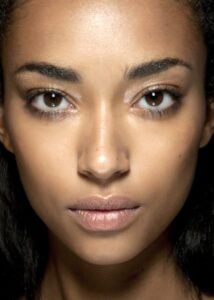Waking up to skin dandruff and more pronounced wrinkles is not how we enjoy starting the day, but just like most people living in climates where humidity levels can go to an extreme low, it’s a reality that just needs to be faced.
During the winter months when humidity is at its lowest – unless you live in the desert where the air is always dry – moisture quickly evaporates in the cool, dry air. Research indicates that exposure to a dry environment is linked to a decrease in skin elasticity and, eventually, to the development of fine lines and wrinkles because the dry air is also sucking moisture from your skin. Now you know one of the reasons why people living in high humidity climates seem to have softer skin and age far less quickly.
As a solution to this, common beauty folklore claims that drinking water increases skin’s hydration levels and therefore wards off wrinkles. Although hydration is necessary for optimal health, there are no concrete studies that directly prove drinking water leads to wrinkle reduction.
Thankfully, for those of us who don’t have the luxury of simply relocating to the tropics for the sake of preventative anti-aging measures (as if we need another excuse), there is another option: investing in a good humidifier. Not only will this increase humidity levels in your environment to keep skin hydrated but also to a certain degree it will help prevent wrinkles. This type of hydration can also aid in the prevention of chapped lips, calm static-ridden hair, and as a health benefit, it can assist in easier breathing by moisturizing nasal passages. Triple bonus!
WHEN TO USE A HUMIDIFIER
So, how do you know when to start using a humidifier?
As mentioned, colder and drier periods of the year like fall and winter are an ideal time of year to use humidifiers, because that’s when humidity levels drop below 30-40%, causing the skin to be at its driest and most prone to chafing.
Research indicates that optimum household humidity should be between 30-60% year round, and maintained at about 30% when temperatures drop below freezing. The best way to test humidity levels in the home or workplace is by using a hygrometer which is a small and inexpensive device that can be found separately or built into digital household thermometers.
PRODUCT RECOMMENDATION
 AcuRite Indoor Humidity Monitor ($8.99)
AcuRite Indoor Humidity Monitor ($8.99)
This wireless tabletop or magnet-mounted hygrometer measures both indoor temperature and humidity. AcuRite’s easy-to-read humidity level icon displays whether the humidity levels are too high, too low or ideal, so you can adjust at the push of a button. The thermometer-hygrometer also collects and indicates the high and low temperatures and humidity levels over the last 24-36 hours and comes with a limited one-year warranty.
THE 3 TYPES OF HUMIDIFIERS
Whether a humidifier is a warm mist, cool mist, or of the ultrasonic variety, there is something positive to be said about each type of humidifier. However, each model also has its drawbacks. Here’s the basic down low on the 3 types of units you can choose from.
WARM MIST
Warm mist humidifiers work by using a heating element to boil water and make it evaporate into an air humidifying steam, which is totally free of minerals and impurities. The warm steam can also double to warm up a chilly room by a couple degrees but is generally only effective in smaller spaces.
Main pro: No filter replacements needed
Main con: Highest power consumption due to the heating element.
COOL MIST
Cool mist humidifiers are the second type of evaporative humidifiers and also the most popular on the market and for good reason. They work using the natural evaporation process of blowing air at water that has soaked into what is called a wick filter. The invisible mist is free from all impurities and, in warmer environments, the cool mist helps to lower room temperatures.
Main Pro: cleanest humidification process
Main Con: filter replacement means higher maintenance
ULTRASONIC
Ultrasonic refers to the method in which the water is converted to mist, so you can get both cool and warm mist ultrasonic humidifiers. The major benefit of an ultrasonic humidifier is that the process of using high-frequency sound waves to break down water molecules makes it the quietest operating humidifier available. This is particularly useful to light sleepers.
Main Pro: near silent operation and no filters
Main Cons: requires distilled water to avoid releasing impurities (such as white dust) in the air.
OTHER CHARACTERISTICS TO LOOK OUT FOR
While the most important thing in a humidifier is its ability to function properly and effectively, many humidifiers boast extra bells and whistles that make your life a bit easier. Here are the more useful extras to look out for:
HUMIDISTAT
A humidistat helps you monitor and control the level of humidity in the room, which is important for ensuring you’re getting enough humidity without overdoing it. When optimal humidity is reached, the humidistat shuts down the unit, effectively avoiding problems like mold and dust mites (ew!). If you end up purchasing a unit without a humidistat, we highly recommend investing in a hygrometer.
TIMER
A timer is a great way to save power without risking precious skin-humidifying time by setting your humidifier to turn on before you get home from work. But beware: you need to be really good about cleaning and drying your unit if you use a timer because water that sits in the tank for hours can otherwise breed microbes.
ULTRAVIOLET (UV) LIGHT
Ultraviolet light is linked to killing 99.9% of bacteria found in water, so if you’re wary about the water you use and don’t want to go through the process of using distilled water, finding a humidifier with a built-in UV bulb is a good option to consider.
OPTIMAL EFFECTIVENESS
Regardless of the type of humidifier you choose, proper usage and maintenance are important in getting optimal performance for anti-aging. Here are some best practices to ensure you get the most bang for your buck:
Thoroughly read the instruction manual – this is the best source of information for knowing how to best care for your specific unit.
Use distilled water – this is the safest way to ensure you’re getting the cleanest humidity available for your precious skin.
Change filters regularly – this goes without saying, but a dirty filter lowers the quality of the air in your room. (Frequency depends on the model and usage, but a good general guideline is changing it every 1-3 months).
Clean with warm soapy water – again, frequency depends on the model and usage, but the general rule for optimal cleanliness is once per week if used daily.
Descale with water and white vinegar – all types of humidifiers are prone to lime or mold build up and should be cleaned at least once per month. The safest and most common way to descale a humidifier is to use a soft brush and a mixture of water and white vinegar (again, consult your manual for specific instructions!)
Drain and dry when not in use – stagnant water that sits for hours or days leads to microbes and bacteria build-up.
Keep away from children and pets – warm mist humidifiers pose a burn risk if tipped over.
RECOMMENDED HUMIDIFIERS
We determined our recommendations based on the following criteria:
- Cleanliness
- Filter Costs
- Coverage
- Noise Level
- Ease of Refill
- Includes Humidistat
BEST ALL ROUNDER
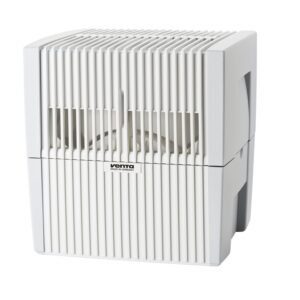 Venta Airwasher 2-in-1 L25 ($299)
Venta Airwasher 2-in-1 L25 ($299)
Although the Venta Airwasher is quite pricey it happens to be our favorite humidifier. It does a great job of cleaning the air of dust and particles and also maintains humidity levels well. Better yet, you only have to give it a good cleaning twice per year, and it doesn’t use any filters which helps offset the high price tag (although there is a recommended cleaning solution that is fairly cost effective and lasts for 6 months). Finally, you can get the same model in 2 alternative sizes depending on spatial requirements! The one above is a 400 square foot room, but there is also a 200 square foot ($200) model for a smaller space or an 800 square foot ($399) model for large spaces.
BUDGET FRIENDLY – WARM MIST
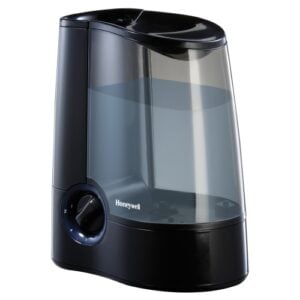 Honeywell HWM705BC ($25.49)
Honeywell HWM705BC ($25.49)
The Honeywell Warm Mist Humidifier is our favorite warm mist humidifier for a handful of reasons. First of all, it’s under $50, making it our most budget-friendly recommendation. It also doesn’t use any filters which makes it, even more, cost-effective in the long run. Other features include a large, easy to fill tank, moisture settings that control output, and an auto shut-off switch. Overall, this unit is a great choice for those who have larger rooms to humidify on a budget.
BUDGET FRIENDLY – COLD MIST
 Honeywell Cool Mist Humidifier HCM-350 ($59.99)
Honeywell Cool Mist Humidifier HCM-350 ($59.99)
Honeywell’s Germ-Free Humidifier is not only affordable, it’s also easy to clean. The single piece unit has no electronics in the reservoir whatsoever, so it’s entirely water submersible and dishwasher safe. This Amazon best-seller rings in under $100 and has cheap filters to boot. The main downside is it doesn’t have a built-in humidistat, but you can get a digital one for $10.
QUIETEST ULTRASONIC
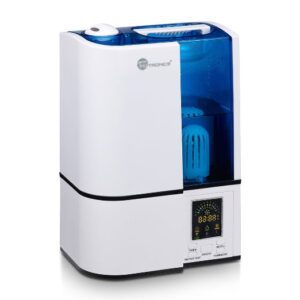 TaoTronics Ultrasonic Humidifier ($65.99)
TaoTronics Ultrasonic Humidifier ($65.99)
The ultrasonic is all about no sound and the TaoTronics Ultrasonic Humidifier delivers just that. This cool mist unit has a built-in antimicrobial and microporous cartridge to eliminate white dust and purify water and is easy to refill. Bonus features include LCD display, humidistat, and a timer.
BEST OF BOTH WORLDS
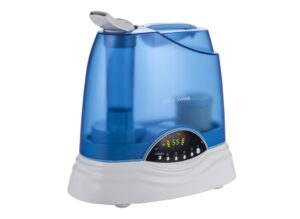 Boneka Warm or Cool Mist Ultrasonic Humidifier ($151.90)
Boneka Warm or Cool Mist Ultrasonic Humidifier ($151.90)
We really like this ultrasonic humidifier because it lets you choose between cool and warm mist which is great for seasonal climates. It also comes fully loaded with an LCD display, humidistat, timer, and is easy to clean. (Just remember to use distilled water to curb white dust!) This unit claims to work in large spaces, but we – along with other reviewers – recommend using it in smaller spaces (200-250 sq.ft) for maximum effectiveness.
FINAL THOUGHTS
If you’re looking to explore some alternative ways to increase skin’s hydration levels read on below:
An effective anti-aging cream will not only help even out skin-tone, target fine lines and wrinkles but also will maximize skin’s moisture levels. Read our guide on the benefits of anti-aging creams for an in-depth exploration into ingredients to look out and all about what they do.
As moisture tends to escape through the skin’s barrier leading to dry skin, nutrient-rich anti-aging facials oils make a good investment to seal in hydration. Learn more through our feature about how to pick effective anti-aging facial oils that will help you decide which one is best for your skin.
Generally speaking, the body may need a different type of oil then the face as it often has different levels of hydration. Don’t worry and we’ve got you covered with our coverage of the best anti-aging body oils.
